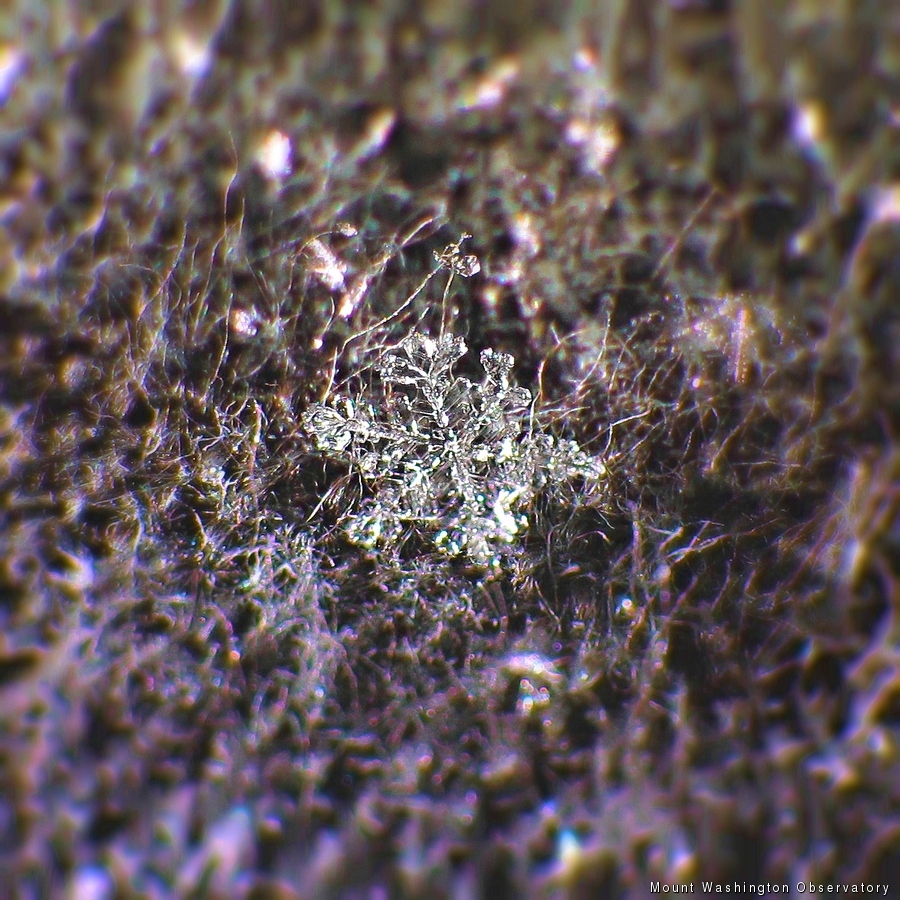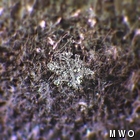Is It Snowing?
2014-01-19 17:34:47.000 – Ryan Knapp, Weather Observer/Meteorologist
Snowflake caught on our snow board.
When I am off the summit and in the valley, I determine it is snowing like almost everyone else – I look out the window and see it falling from the sky or look at recently shoveled areas to see if anything has accumulated. On the summit of Mount Washington, this method rarely works. Why? Well, we are usually in the fog and there is some amount of blowing snow/ice/rime that is being whipped up with the newly fallen snow. So, my valley method of just looking out a window to determine if it is snowing will rarely work. So, how do we know if it is snowing on the summit of Mount Washington?
While my valley method rarely works, it does on occasion work (yesterday was one of those days). When the winds are low enough and the fog is thin enough, visually inspecting the surrounding vistas is one method to determine if it is snowing. If we look out and the snow is falling vertically instead of horizontally and there is maybe some accumulation on the rocks around us, there is a pretty good chance it is snowing. This works at night too as we use a ‘snow light‘ to shine a bright light across the horizon. If the snow is blowing horizontal to the ground, usually that indicates blowing snow and if it is coming down vertically or at a high enough angle, it is falling from the sky. But just looking out a window doesn’t always cut it. And that is why we have to head outside.
As we head out, we grab what is called a snow board. Read that I said a snow board and not a snowboard which is what you would find at a ski resort. Our snow board is a one foot by one foot square piece of plywood covered in black felt. This allows us to head outside and catch whatever flakes are present in the air. We often get asked, ‘But aren’t the flakes too small to see?’ Not at all. Next time it is snowing, head out with a pair of wool gloves and catch some flakes by just holding your glove out flat and letting them land on you. Upon closer inspection you will be able to see the shape of the flake. Well, we do the same with the board. We hold it out and let the snow settle on it and then inspect what we caught. If the snowflake or snow grain is whole and nearly symmetrical, it fell from the sky. If it is sheered in half, missing a branch or side branches, or just looks broken, it means it was broken up as it was blowing – either crashing into other flakes, the ground, humans, or other solid objects. For a crude artist rendition of what we look for, head here (and to save you from writing an email to me, I already know the flakes are incorrect and should have six sides).
After physically determining that it is snowing, the last determination is by looking at radar. For some, this might be counterintuitive – why not start with radar and then physically check? Doppler radar is a useful tool in determining whether or not it is precipitating but it isn’t foolproof. One instance might be when moisture is falling into a dry layer, it might be evaporating before it hits the ground creating virga. The monitor will make it look like it is precipitating when in reality nothing is reaching the ground. Or, for the case we run into most often, we are getting a light upslope flow that the radar is not able to pick up on. We are catching flakes but nothing is showing up on the closest radar in Gray, ME.
So, this is how we determine it is snowing on the summit of Mount Washington. So, the next time it is snowing in your area, don’t just look at a screen or out a window, get outside and really look at it. And if you want to take it a step further and get involved in weather observing by reporting what you are seeing, if you have a smartphone you can get involved in the Meteorological Phenomena Identification Near the Ground (mPING) Project. To learn more about this project and get links to the apps for your phone, you can head here.
Ryan Knapp, Weather Observer/Meteorologist
Team Flags Return for Seek the Peak’s 25th Anniversary
Team Flags Return for Seek the Peak's 25th Anniversary By MWOBS Staff Mount Washington Observatory is looking forward to continuing a much-loved tradition for Seek the Peak’s 25th Anniversary: Team flags. In inviting teams
Meet Summer Interns Zakiya, Max and Maddie
Meet Summer Interns Zakiya, Max and Maddie By MWOBS Staff We are excited to welcome six teammates to the summit of Mount Washington this summer! During their internship, these students and graduates will play
Saying Goodbye to the Summit
Saying Goodbye to the Summit By Alexis George After an extraordinary last three years working as a Weather Observer and Meteorologist, I am excited to pursue a different career. As sad I as am






